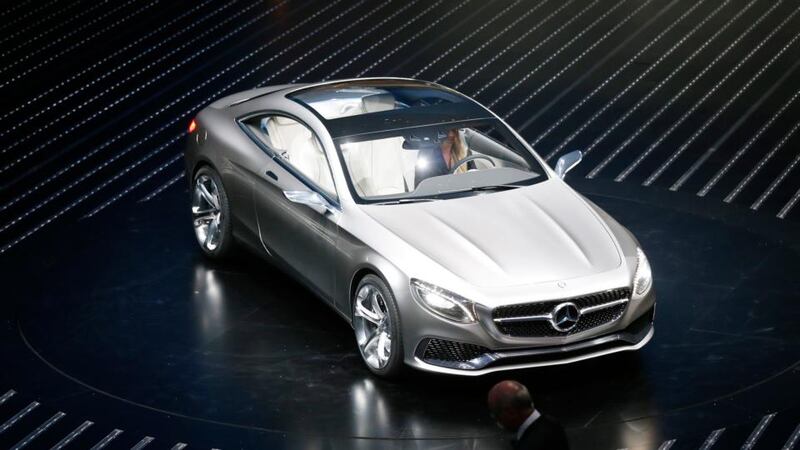A big, luxurious coupe is traditionally the model which sits atop the Mercedes product tree, and for the past three decades, that model has been badged as the CL. Well, no longer; it will from now on be S-Class Coupe and Mercedes has just whipped the covers from a concept version of that car at the Frankfurt motor show.
As with so many current concepts, this is a concept in name and detail only and is in fact very, very close to the final production version of Mercedes’ range topper. It’s certainly big enough to be imposing, braking the tape measure at just over 5-metres, and a 2.9-metre wheelbase should ensure that in spite of the coupe name, it will provide luxurious cabin accommodation even to rear seat passengers.
It’s also really rather gorgeous, far more so than that rather-too-conservative new S-Class saloon with which it shares its underpinnings. There’s a lot of A-Class, SL and SLS in the design and the overal look is pretty stunning.

Gorden Wagener, Vice President Design at Mercedes said at the unveiling that "the Concept S Class Coupé combines tradition and emotion, and is a symbol for the embodiment of our design style of sensual clarity. The perfected design with self-assured style and the highly exclusive appointments make the coupé a true design icon and an expression of modern luxury. Design needs the sublime. Because design is the best brand ambassador. At the centre of our work is sensual clarity as an expression of modern luxury, because this is precisely what gets to the heart of our brand philosophy - the bipolarity of intelligence and emotion."
As with the S-Class saloon, the exterior lighting is done entirely by LEDs, with a new ‘eyebrow’ signature for the daytime running lights, and a diamond-effect look for the main beam lamps. The engine is a modified version of the turbo V8 petrol already seen in the SL and S-Class, and here it develops 455hp and 700Nm of torque. As with the S-Class saloon, the Coupe has the road-scanning radar that detects poor surfaces ahead and prepares the suspension to get out of the way, keeping the ride as calm and flat as possible for those inside.
Inside, the cabin includes a touch-screen displaying four world clocks (presumably to keep track of your global stock investments), retro-futuristic looking air vents and a centre console inlaid with a chemically etched precious metal surface that’s supposed to be exceptionally scratch resistant.
"The new S-Class Saloon was received enthusiastically in the market and perfectly lives up to its role as a representative of the power of innovation of Mercedes-Benz, " said Dr Joachim Schmidt, head of Mercedes Sales & Marketing. "On the S-Class Coupé as the traditional top of our product range the designers take advantage of their additional freedom and thus create an automotive masterpiece."
A big, luxurious coupe is traditionally the model which sits atop the Mercedes p
Mercedes is already making some bold tech statement at the show as well. It plans to start selling a self-driving car by 2020 as part of its campaign to regain the top spot among premium carmakers, its development chief said. Carmakers and suppliers across the world are working on ways to make driving safer and more comfortable through automation, and the race is on to bring the technology to the mass market.
“We want to be the first to launch autonomous functions in production vehicles. You can be sure: we will accomplish that in this decade,” Daimler head of development Thomas Weber said. He describes a car that would recognise difficult situations such as dealing with traffic lights or urban driving among pedestrians and cyclists, and hand control back to the human behind the wheel.
Weber said it was hard to forecast exactly when drivers would turn into passengers in their own cars. “Autonomous driving will not come overnight, but will be realised in stages,” he said.
One obstacle to overcome is making it legal for cars to steer themselves. European Union laws currently call for drivers to be in control of cars at all times, so test vehicles at Daimler and BMW need special approval in Germany. A Mercedes test vehicle recently travelled the same 100-km stretch between the German cities of Mannheim and Pforzheim that Bertha Benz drove 125 years ago.
There’s also the challenge of convincing drivers of the technology, although Georgeric Legros, a Paris-based management consultant with AlixPartners, believes attitudes are changing. “The slightly macho aspect of cars is gradually disappearing in favour of a more functional, safety-minded image,” he said. “People prefer to be comfortably installed in a leather seat, reading the paper or catching up on email, rather than stuck behind the wheel in a traffic jam or on a monotonous motorway.”
Technology already on the market allows partly automated driving in which motorists stay in control but get a hand from the vehicle.
Mercedes sees itself ahead in the race to develop robot cars because it says its technology can handle city driving as well as motorways. It uses readily available sensors rather than specially designed technologies for research vehicles.



















